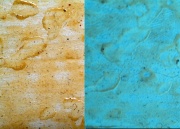Difference between pages "Butane" and "Stand oil"
| Line 1: | Line 1: | ||
| + | [[File:51-69_Stand.Oil_canvas.jpg|thumb|Stand oil]] | ||
== Description == | == Description == | ||
| − | A | + | A pale, thick, concentrated form of [[linseed%20oil|linseed oil]]. Stand oil is prepared by anaerobically heating linseed oil to about 300C. This allows the oil to partially polymerize without any [[oxidation|oxidation]] occurring. Aneorobic conditions are obtained using a vacuum or [[carbon%20dioxide|carbon dioxide]] atmosphere. Stand oil was likely developed by the Dutch in the 19th century. Stand oil dries more slowly and yellows less than untreated linseed oil. It forms a tough, flexible film that is resistant to weathering. Stand oils have been used in [[varnish|varnishes]], glazes, and as a high viscosity additive to other paint media. Half oil is 50% stand oil and 50% [[turpentine%20%28oil%29|turpentine]]. |
== Synonyms and Related Terms == | == Synonyms and Related Terms == | ||
| − | + | Standöle (Deut.); standoil (It); olio standolizzato (It); half oil; standoil; polymerized oil; lithographic oil; English oil varnish; | |
| − | == | + | == Physical and Chemical Properties == |
| − | * | + | * Iodine number is lower than linseed oil. |
| − | + | * Produces a greenish iridescent fluorescence. | |
| − | * | ||
| − | == | + | ==Resources and Citations== |
| − | + | * R. J. Gettens, G.L. Stout, ''Painting Materials, A Short Encyclopaedia'', Dover Publications, New York, 1966 | |
| − | |||
| − | |||
| − | |||
| − | |||
| − | |||
| − | |||
| − | |||
| − | |||
| − | |||
| − | |||
| − | |||
| − | |||
| − | |||
| − | |||
| − | |||
| − | |||
| − | + | * M. Doerner, ''The Materials of the Artist'', Harcourt, Brace & Co., 1934 | |
| − | * G.S.Brady, ''Materials Handbook'', McGraw-Hill Book Co., New York, 1971 Comment: p. | + | * G.S.Brady, ''Materials Handbook'', McGraw-Hill Book Co., New York, 1971 Comment: p. 458 |
| − | * | + | * Reed Kay, ''The Painter's Guide To Studio Methods and Materials'', Prentice-Hall, Inc., Englewood Cliffs, NJ, 1983 |
| − | * '' | + | * Ralph Mayer, ''A Dictionary of Art Terms and Techniques'', Harper and Row Publishers, New York, 1969 (also 1945 printing) |
| − | * | + | * Hermann Kuhn, ''Conservation and Restoration of Works of Art and Antiquities'', Butterworths, London, 1986 |
| − | * '' | + | * Pam Hatchfield, ''Pollutants in the Museum Environment'', Archetype Press, London, 2002 |
* Art and Architecture Thesaurus Online, https://www.getty.edu/research/tools/vocabulary/aat/, J. Paul Getty Trust, Los Angeles, 2000 | * Art and Architecture Thesaurus Online, https://www.getty.edu/research/tools/vocabulary/aat/, J. Paul Getty Trust, Los Angeles, 2000 | ||
Latest revision as of 14:52, 4 June 2022
Description
A pale, thick, concentrated form of Linseed oil. Stand oil is prepared by anaerobically heating linseed oil to about 300C. This allows the oil to partially polymerize without any Oxidation occurring. Aneorobic conditions are obtained using a vacuum or Carbon dioxide atmosphere. Stand oil was likely developed by the Dutch in the 19th century. Stand oil dries more slowly and yellows less than untreated linseed oil. It forms a tough, flexible film that is resistant to weathering. Stand oils have been used in varnishes, glazes, and as a high viscosity additive to other paint media. Half oil is 50% stand oil and 50% turpentine.
Synonyms and Related Terms
Standöle (Deut.); standoil (It); olio standolizzato (It); half oil; standoil; polymerized oil; lithographic oil; English oil varnish;
Physical and Chemical Properties
- Iodine number is lower than linseed oil.
- Produces a greenish iridescent fluorescence.
Resources and Citations
- R. J. Gettens, G.L. Stout, Painting Materials, A Short Encyclopaedia, Dover Publications, New York, 1966
- M. Doerner, The Materials of the Artist, Harcourt, Brace & Co., 1934
- G.S.Brady, Materials Handbook, McGraw-Hill Book Co., New York, 1971 Comment: p. 458
- Reed Kay, The Painter's Guide To Studio Methods and Materials, Prentice-Hall, Inc., Englewood Cliffs, NJ, 1983
- Ralph Mayer, A Dictionary of Art Terms and Techniques, Harper and Row Publishers, New York, 1969 (also 1945 printing)
- Hermann Kuhn, Conservation and Restoration of Works of Art and Antiquities, Butterworths, London, 1986
- Pam Hatchfield, Pollutants in the Museum Environment, Archetype Press, London, 2002
- Art and Architecture Thesaurus Online, https://www.getty.edu/research/tools/vocabulary/aat/, J. Paul Getty Trust, Los Angeles, 2000
